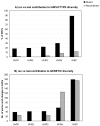Accelerated microevolution in an outer membrane protein (OMP) of the intracellular bacteria Wolbachia
- PMID: 20163713
- PMCID: PMC2843615
- DOI: 10.1186/1471-2148-10-48
Accelerated microevolution in an outer membrane protein (OMP) of the intracellular bacteria Wolbachia
Abstract
Background: Outer membrane proteins (OMPs) of Gram-negative bacteria are key players in the biology of bacterial-host interactions. However, while considerable attention has been given to OMPs of vertebrate pathogens, relatively little is known about the role of these proteins in bacteria that primarily infect invertebrates. One such OMP is found in the intracellular bacteria Wolbachia, which are widespread symbionts of arthropods and filarial nematodes. Recent experimental studies have shown that the Wolbachia surface protein (WSP) can trigger host immune responses and control cell death programming in humans, suggesting a key role of WSP for establishment and persistence of the symbiosis in arthropods.
Results: Here we performed an analysis of 515 unique alleles found in 831 Wolbachia isolates, to investigate WSP structure, microevolution and population genetics. WSP shows an eight-strand transmembrane beta-barrel structure with four extracellular loops containing hypervariable regions (HVRs). A clustering approach based upon patterns of HVR haplotype diversity was used to group similar WSP sequences and to estimate the relative contribution of mutation and recombination during early stages of protein divergence. Results indicate that although point mutations generate most of the new protein haplotypes, recombination is a predominant force triggering diversity since the very first steps of protein evolution, causing at least 50% of the total amino acid variation observed in recently diverged proteins. Analysis of synonymous variants indicates that individual WSP protein types are subject to a very rapid turnover and that HVRs can accommodate a virtually unlimited repertoire of peptides. Overall distribution of WSP across hosts supports a non-random association of WSP with the host genus, although extensive horizontal transfer has occurred also in recent times.
Conclusions: In OMPs of vertebrate pathogens, large recombination impact, positive selection, reduced structural and compositional constraints, and extensive lateral gene transfer are considered hallmarks of evolution in response to the adaptive immune system. However, Wolbachia do not infect vertebrates. Here we predict that the rapid turnover of WSP loop motifs could aid in evading or inhibiting the invertebrate innate immune response. Overall, these features identify WSP as a strong candidate for future studies of host-Wolbachia interactions that affect establishment and persistence of this widespread endosymbiosis.
Figures






Similar articles
-
Mosaic nature of the wolbachia surface protein.J Bacteriol. 2005 Aug;187(15):5406-18. doi: 10.1128/JB.187.15.5406-5418.2005. J Bacteriol. 2005. PMID: 16030235 Free PMC article.
-
wsp gene sequences from the Wolbachia of filarial nematodes.Curr Microbiol. 2000 Aug;41(2):96-100. doi: 10.1007/s002840010100. Curr Microbiol. 2000. PMID: 10856373
-
Different rates of nucleotide substitutions in Wolbachia endosymbionts of arthropods and nematodes: arms race or host shifts?Parassitologia. 2002 Dec;44(3-4):179-87. Parassitologia. 2002. PMID: 12701381
-
Wolbachia: master manipulators of invertebrate biology.Nat Rev Microbiol. 2008 Oct;6(10):741-51. doi: 10.1038/nrmicro1969. Nat Rev Microbiol. 2008. PMID: 18794912 Review.
-
The Wolbachia Endosymbionts.Microbiol Spectr. 2019 Mar;7(2):10.1128/microbiolspec.bai-0018-2019. doi: 10.1128/microbiolspec.BAI-0018-2019. Microbiol Spectr. 2019. PMID: 30953430 Free PMC article. Review.
Cited by
-
Mosaic Evolution of Beta-Barrel-Porin-Encoding Genes in Escherichia coli.Appl Environ Microbiol. 2022 Apr 12;88(7):e0006022. doi: 10.1128/aem.00060-22. Epub 2022 Mar 14. Appl Environ Microbiol. 2022. PMID: 35285711 Free PMC article.
-
Wolbachia infection status and molecular diversity in the species of tribe Tagiadini Mabille, 1878 (Lepidoptera: Hesperiidae) collected in China.Ecol Evol. 2024 Apr 16;14(4):e11279. doi: 10.1002/ece3.11279. eCollection 2024 Apr. Ecol Evol. 2024. PMID: 38633519 Free PMC article.
-
Uncovering Wolbachia diversity upon artificial host transfer.PLoS One. 2013 Dec 20;8(12):e82402. doi: 10.1371/journal.pone.0082402. eCollection 2013. PLoS One. 2013. PMID: 24376534 Free PMC article.
-
A potential role for the interaction of Wolbachia surface proteins with the Brugia malayi glycolytic enzymes and cytoskeleton in maintenance of endosymbiosis.PLoS Negl Trop Dis. 2013 Apr 4;7(4):e2151. doi: 10.1371/journal.pntd.0002151. Print 2013. PLoS Negl Trop Dis. 2013. PMID: 23593519 Free PMC article.
-
Evidence for Common Horizontal Transmission of Wolbachia among Ants and Ant Crickets: Kleptoparasitism Added to the List.Microorganisms. 2020 May 27;8(6):805. doi: 10.3390/microorganisms8060805. Microorganisms. 2020. PMID: 32471038 Free PMC article.
References
Publication types
MeSH terms
Substances
LinkOut - more resources
Full Text Sources

